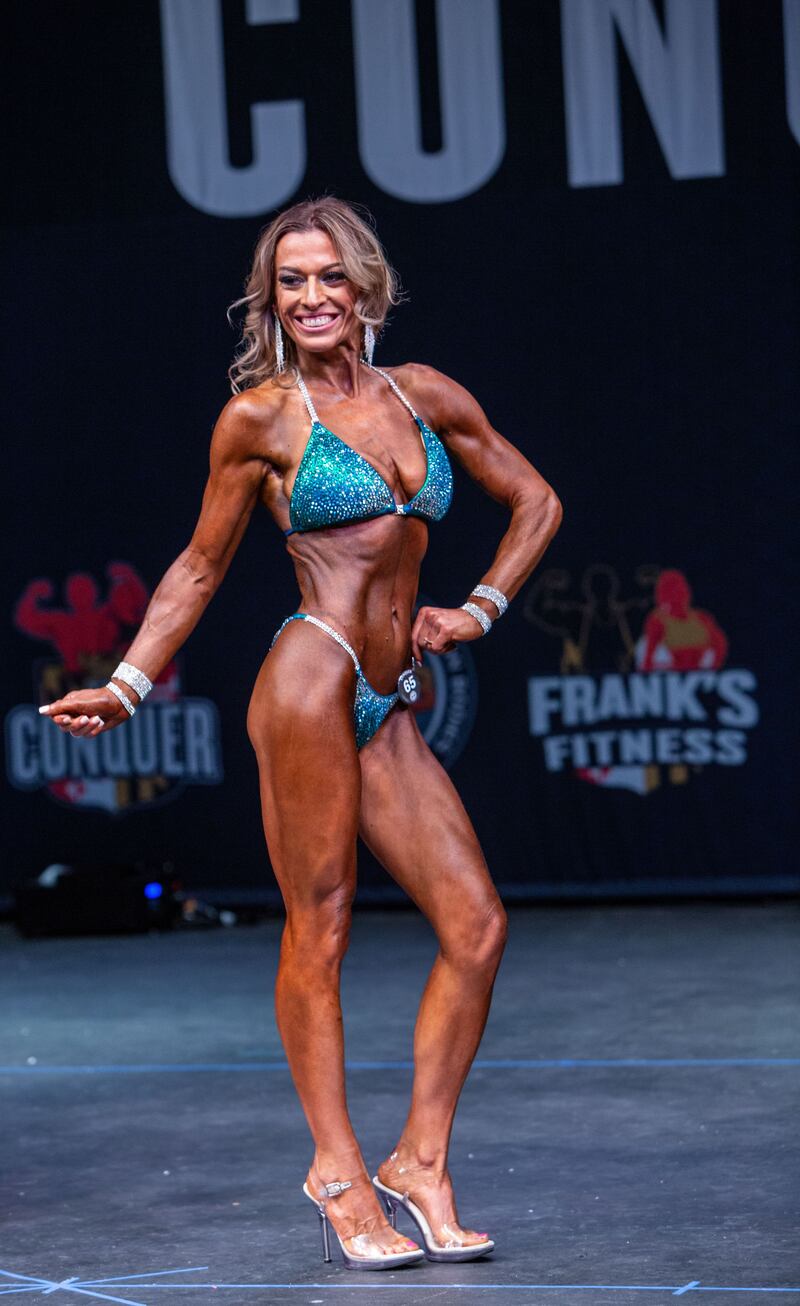In a few weeks, I’ll step onstage in a rhinestone bikini the size of a sandwich bag. I’ll be flexing under stadium lights, in 3-inch heels, after months of training, food prep, posing practice and hormone swings. I’m a 50-year-old bodybuilder—and this will be my first show as a pro.
Six years ago, this life would’ve sounded like satire. I was deep in the wreckage of loss: My father had died unexpectedly, my marriage had ended and I was numbing myself with alcohol. My body felt like a stranger’s. I was stuck in every possible way.
Then, one morning in a hotel gym, I saw a woman deadlifting. She looked strong, focused—and free. I struck up a conversation, and she introduced me to the world of strength sports. That chance encounter cracked open something long-dormant in me.
Soon, I found a coach: Tina Peratino, a retired bodybuilder in Bowie, Maryland. Tina taught me to eat more, not less—to fuel, not punish. That going to the gym didn’t mean (in her words) becoming a “cardio bunny.” She flipped everything I thought I knew about fitness, food–and femininity.
It wasn’t all sunshine and PRs. I slipped more than once. During the height of the Covid-19 pandemic, I found myself stress-eating my kids’ snack-sized lunchbox treats. When the gyms shut down, I felt sluggish and unmotivated, dragging myself through half-hearted home workouts.

But I never quit on myself. And along the way, something shifted. It wasn’t just my body that changed–though it did. At 45, for the first time in my life, I wore a two-piece swimsuit. But as I built muscle, I also built resilience. I stopped leaning on alcohol. I stood taller. I took risks—like putting myself out there with a dating profile. (That’s how I met my partner.) I spoke up at work. For the first time, I felt like I truly inhabited my own skin.
As a journalist, I needed to understand why. Why had muscle made me feel so alive? Why had I spent decades trying to disappear?
The science of building, not shrinking
Turns out, I was never supposed to shrink in the first place.
For most of human history, women weren’t meant to be thin—they were meant to be strong. Prehistoric women had denser bones and more upper-body strength than we imagined. One study out of Cambridge )” href=”https://urldefense.com/v3/__https:/www.cam.ac.uk/research/news/prehistoric-womens-manual-work-was-tougher-than-rowing-in-todays-elite-boat-crews__;!!LsXw!SbtRuRb6vB8qNLVjxNuwmBn3GS6lHLehRlv6m7JJO7K0Us8DQ1d6TERuxMj2d8jHakDeRt8IeeKm9S6X7auDGSOJ$” rel=””>One study out of Cambridge found that Neolithic women’s arm bones were up to 16% stronger than those of elite rowers today.
That strength wasn’t cosmetic. It was survival. These women ground grain by hand, hauled water and tilled fields. Their bodies were built for effort. For endurance.
Our obsession with thinness, by contrast, is a modern glitch. It emerged in the late 19th century, as food became more abundant and a svelte figure came to signal wealth, restraint, and moral virtue. Calorie-counting, corsets and crash diets followed. Then came Twiggy, heroin chic, and now, the Ozempic era.
Each wave of body fixation seems to arrive right as women are poised to gain power.
The flapper look rose after suffrage. The boyish silhouette popularized by models in the mod era coincided with the rise of second-wave feminism. In the ’90s, just as women flooded law firms and boardrooms, we got the waif era. Today, injectable appetite suppressants are booming—right as reproductive rights hang in the balance and we nearly elected our first female president. These aren’t coincidences—they’re cultural backlash, repackaged as beauty trends.
And here’s what’s even more maddening: biologically, women already have an edge. We may not always be the strongest in terms of brute force, but we are often the toughest. We are built differently—built to last.
Women outlive men across cultures worldwide by 5 to 20 percent, according to Steven Austad of the American Federation for Aging Research. Three-quarters of centenarians are women. Scientists speculate it’s everything from a more robust immune system to hormonal advantages to the evolutionary grit that comes from caregiving.
The new status symbol is strength
And in the weight room? We’re no slouches. Sandra Hunter, chair of movement science in the School of Kinesiology at the University of Michigan, who works to understand sex differences in athletic performance, has found that women fatigue more slowly than men. Her 2016 review of over 50 studies found women, on average, outlasted men by 36% in muscle endurance.
A new aesthetic is emerging—and, gym executives say, females are beginning to outnumber men in weight rooms.
The result? Crunch Fitness has cut its cardio equipment in half to make space for weights. The Life Time chain of health clubs have done the same. Orangetheory now offers strength-only classes. Peloton recently launched a standalone strength-focused app.

Tunde Oyeneyin, one of Peloton’s most popular instructors, says even she used to hide her muscular physique. Now women come up to her and say: “I want arms like yours.”
Because that’s what I’ve come to believe: the future of female power isn’t about subtracting—it’s about adding.
I used to think reinvention required a grand epiphany. But really, it starts with small acts. A commitment to oneself. Saying no to the bullsh-t. Saying yes to a dumbbell.
At 50, I’m stronger than I’ve ever been—not in spite of age or menopause or setbacks, but because of them. My body has carried all of it—and still, it rises.
Anne Marie Chaker is a journalist, professional bodybuilder and author of the forthcoming book LIFT: How Women Can Reclaim Their Physical Power and Transform Their Lives,)” href=”https://urldefense.com/v3/__https:/www.penguinrandomhouse.com/books/709922/lift-by-anne-marie-chaker/__;!!LsXw!SbtRuRb6vB8qNLVjxNuwmBn3GS6lHLehRlv6m7JJO7K0Us8DQ1d6TERuxMj2d8jHakDeRt8IeeKm9S6X7brWTvez$” rel=””> LIFT: How Women Can Reclaim Their Physical Power and Transform Their Lives, out June 17 from Penguin Random House.
The post I’m 50, in Perimenopause—and About to Compete as a Pro Bodybuilder appeared first on The Daily Beast.




